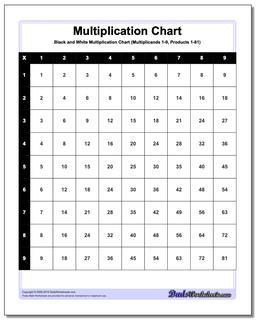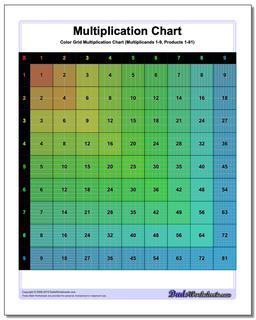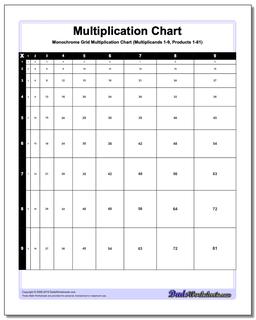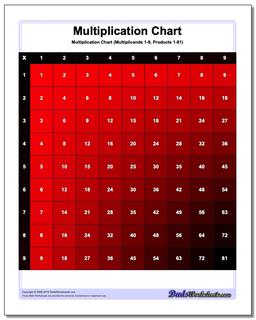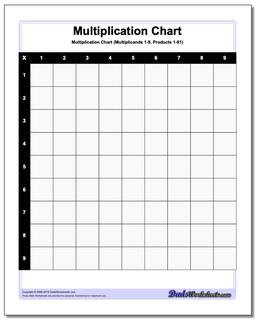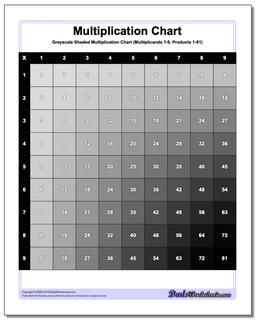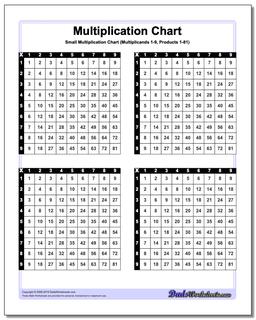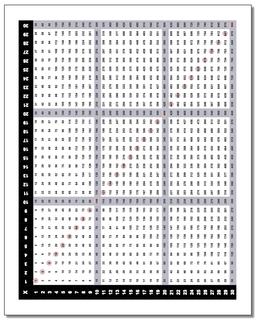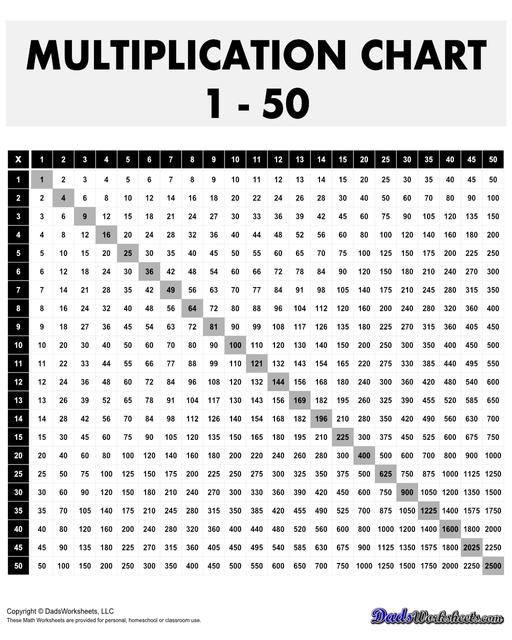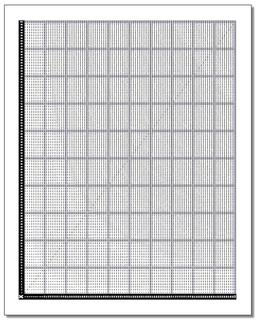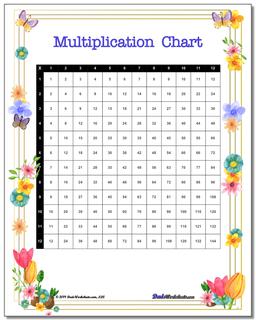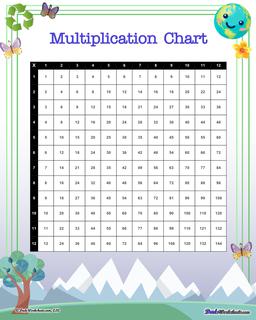Core Math Worksheets
Fraction Worksheets
Word Problems
Algebra and Trigonometry
Other Worksheets
Place Value
Percentages
Rounding Numbers
Ordering Numbers
Standard, Expanded, Word Form
Mean Median Mode Range
Ratio Worksheets
Probability Worksheets
Roman Numerals
Factorization, GCD, LCM
Prime and Composite Numbers
Pre-Algebra
Geometry Worksheets
Blank Clocks
Telling Analog Time
Analog Elapsed Time
Greater Than and Less Than
Money
Arithmetic Sequences
Geometric Sequences
Venn Diagram
Graph Worksheets
Measurement & Conversions
Patterns and Puzzles
Color by Number
Holiday & Seasonal
Early Learning
Printables
Calculators
Multiplication Charts: [Updated!] 86 High Resolution Printable PDFs, 1-10, 1-12, 1-15 and More!
Do you have students working to memorize their multiplication facts? This page offers 70 PDF files of multiplication charts that can be printed out and used as a reference or a teaching aid. There are varieties of conventional multiplication charts with facts from 1-9 (products 1-81), 1-10 (products 1-100), 1-12 (products 1-144), and 1-15 (products 1-255), in addition to the fun color versions below. The multiplication facts print wonderfully since each of these multiplication charts is a high definition SVG. Check out the many chart options by scrolling down, and at the bottom of the page, you'll find some useful advice for utilizing multiplication charts.
Multiplication Charts
More Multiplication Charts Below!
Looking for more conventional multiplication charts in formats with larger products? Click through some of the links below to explore the many chart variations ready for your printer!
Black and White Multiplication Chart
4 Multiplication Charts
This version of the chart presents the multiplication table in a basic black and white grid. There are different variations of each multiplication chart with facts from 1-9 (products 1-81), 1-10 (products 1-100), 1-12 (products 1-144) and 1-15 (products 1-255).
Black and White Multiplication ChartGrid Multiplication Chart
8 Multiplication Charts
This printable chart presents the multiplication table with cells divided to reflect the actual product. Separate black and white and color versions of the multiplication chart, each with ranges 1-9, 1-10, 1-12 and 1-15.
Grid Multiplication ChartProportioned Multiplication Chart
8 Multiplication Charts
This printable multiplication chart presents the products where their sizes are relative to the answer. This is a great way to see the size and scale of each product relative to the others in the chart. Each multiplication chart has black and white and colored versions.
Proportioned Multiplication ChartColor Multiplication Chart
16 Multiplication Charts
These versions of the multiplication chart are drawn in glorious red, green, blue or rainbow color schemes. Charts for multiplicands 1-9 (products 1-81), 1-10 (products 1-100), 1-12 (products 1-144) and 1-15 (products 1-255)
Color Multiplication ChartBlank Multiplication Chart
4 Multiplication Charts
Each blank multiplication chart in this section allows students to fill in their own set of multiplication facts for reference. There are different variations of each multiplication chart with facts from 1-9 (products 1-81), 1-10 (products 1-100), 1-12 (products 1-144) and 1-15 (products 1-255).
Blank Multiplication ChartShaded Multiplication Chart
4 Multiplication Charts
These multiplication charts present the multiplication table with each multiplication fact shaded to reflect the product. Larger multiplication products are shaded darker on the chart.
Shaded Multiplication ChartSmall Multiplication Chart
12 Multiplication Charts
Do you need a small printable multiplication table you can put in your pocket, tape to student desks or laminate and hand out at parties? You MIGHT be a math teacher! Any place you need multiplication in a flash, these charts will be there for you! These multiplication tables appear small on the screen, but they are vector images designed to be printable at high resolution and will be razor sharp on your printer.
Small Multiplication ChartMultiplication Chart 30x30
1 Multiplication Chart
A 30x30 multiplication chart provides a great way to start exploring patterns in the times table that extend past your basic 1-12 or even 1-15 facts. This printable PDF is a great tool for middle-school students who are ready to expand their multiplication skills.
Multiplication Chart 30x30Multiplication Chart 50x50
25 Multiplication Charts
A complete collection of 50x50 multiplication reference chart, each goes all the way to 2500! Here's a wakeup call for those middle school students who think multiplication facts stop at 100!
Multiplication Chart 50x50Multiplication Chart 100x100
One Amazing Multiplication Chart with 10,000 Facts!
It's big! It's huge! It's the Multiplication Chart 100x100! You may not think you need this many multiplication facts on one printable page, but you don't know until you get to multiplying!
Multiplication Chart 100x100Themed Multiplication Charts
Printable Multiplication Charts
Memorizing the multiplication facts is one of the most important math skills we can teach our kids. Without times table mastery, more advanced math topics are infinitely more challenging. As we're learning multiplication facts, having a complete multiplication chart around can be a bridge to success in all areas of mathematics. Find a chart suitable for your kids current level of fact memorization, print it out and keep it on hand...especially when you are just starting multi-digit multiplication.
Is It Important to Memorize the Multiplication Tables?
The idea that all grade school pupils should learn their multiplication tables used to be fairly uncontroversial, but with the popularity of "new math" in many educational systems, this idea is now frequently contested. However, there are a lot of strong arguments for why learning the multiplication table by heart may help a student significantly in arithmetic and many other areas.
Numerous competencies in arithmetic alone need a command of the multiplication table. The capacity of a learner to swiftly multiply or factor numbers (basically "reversing" multiplication) to solve problems is necessary for manipulating algebraic equations, long division, fractions, and even elementary geometry. These abilities are exceedingly difficult to master without quick recollection of multiplication facts.
In other subjects, especially the physical sciences, multiplication plays a role in solving problems. Even the most basic physics class will use multiplication regularly. Some educators argue that these classes introduce electronic calculators making recall of multiplication facts anachronistic, however just basic intuition about the reasonableness of multiplication products is critical to understanding concepts as well as whether an answer to a problem is appropriate (or the mistaken result of missing a key punching numbers into a calculator).
We use multiplication regularly in every day life, and a student who doesn't know how to multiple will struggle as an adult to calculate everyday problems like sales tax, restaurant tips or buying in quantity. No educated adult should struggle with basic financial decisions or require a pocket calculator every time the encounter a two digit number.
In short, memorizing the multiplication chart remains important today.
What grade should kids learn the multiplication facts?
The age where a child is ready to learn the multiplication table can vary depending on their skill with addition and subtraction, but generally nine year old or 3rd grade students should be practicing their multiplication facts frequently and they should have the multiplication chart largely memorized by the start of 4th grade.
When a child understands repeated addition or skip counting, it's usually a good time to start introducing simple multiplication problems. Students with strong addition skills in 2nd grade may start learning multiplication, but typically 3rd grade students are expected to start memorizing their multiplication facts as part of their regular math curriculum.
How Do I Teach My Child Multiplication Tables?
Here's a list of time tested strategies for teaching multiplication to kids:
- Start with a set of mnemonics or rules for learning the times tables to provide a framework for different math facts.
- Always have a multiplication chart' on hand for quick reference.
- Practice with incremental multiplication worksheets to learn the math facts a few at a time until mastery is achieved.
- Drill with multiplication flash cards as an alternative practice activity where pencil and paper aren't available.
- Practice multiplication facts in every day situations such as the grocery store, cooking in the kitchen, figuring out rewards for chores or any place where numbers work their way into day-to-day life.
How can multiplication tables be used to understand other concepts?
Multiplication crops up in many situations, and there is no shortage of situations where multiplication skills can be applied to understand other concepts.
Cooking is a great example where doubling or tripling a recipe provides a great opportunity for multiplication practice. Having that multiplication chart right next to a measurement conversion chart should be a given in the kitchen!
Time and distance word problems are another area where multiplication skills extend readily into real world opportunities to practice.
Investing and finance is another area where multiplication skills assist in determining things like market capitalization from share price, total returns from an investment and many other important quantities. If a career in finance is in your protege's future, master of the multiplication facts should be an important early milestone.
You can use a multiplication chart to illustrate how skip counting can be used as a strategy for learning the multiplication facts, or try printing one of the black and white multiplication chart PDFs and have kids color each product a different color. This can help build awareness of how a product like 24 can be made from various multiplication facts like 4x6, 6x4, 3x8, 8x3 and 2x12. A multiplication chart can also be a useful tool when learning the division facts. By finding the dividend in the body of the chart, kids can trace back to the margins to determine divisors and quotients for whole numbers.
All of these are important reasons why a having a multiplication chart on hand is important to learning the times tables. Beyond these charts, you can find Multiplication Worksheets here, including Multiplication Grids where students fill in the missing multiplication products.
These multiplication charts are a great reference, but also be sure to check out the Multiplication Table page, which includes more great practice for students just getting started with their multiplication skills!

Multiplication Chart History


















